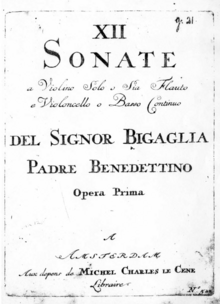Diogenio Bigaglia (about 1678–1745) was a Venetian monk, and a well-known composer and virtuoso of his time.[1]: 94
Diogenio Bigaglia | |
|---|---|
 Title-page of the XII Sonate a Violino Solo o sia Flauto, Amsterdam: Le Cène, circa 1722 | |
| Born | about 1676 Murano, Republic of Venice |
| Died | about 1745 Venice, Republic of Venice |
| Occupation | Benedictine monk |
| Language | Italian |
| Nationality | Venetian |
Life
editBigaglia was born on the island of Murano, just north of Venice. He entered the Benedictine monastery of San Giorgio Maggiore in Venice in 1694. In 1700 he was ordained a priest, and in 1713 became the prior of the monastery.[2][3]
Works
editHe composed both sacred and secular vocal works. Of his larger sacred compositions little has survived. His instrumental music includes several polyphonic concerti and solo works, notably his 12 sonatas for violin or recorder (flauto) and basso continuo Opus 1, published by Le Cène in Amsterdam in about 1722[2] or 1723.[4]: 700
References
edit- ^ Johann Gottfried Walther (1732). Musicalisches Lexicon Oder Musicalische Bibliothec (in German). Leipzig: Deer.
- ^ a b Sven Hansell, Olga Termini. Bigaglia, Diogenio. Grove Music Online. Oxford: Oxford University Press. doi:10.1093/gmo/9781561592630.article.03066. (subscription required).
- ^ Thiemo Wind (1984). Bigaglia's Sonata in A minor, a new look at its originality. The Recorder and Music Magazine. 8 (2): 49-54.
- ^ Sven Hansell (1980). 'Bigaglia, Diogenio'. In: Stanley Sadie (editor) (1980). The New Grove Dictionary of Music and Musicians, sixth printing, volume 2 (Back to Bolivia). London: Macmillan Publishers Limited. ISBN 0333231112.